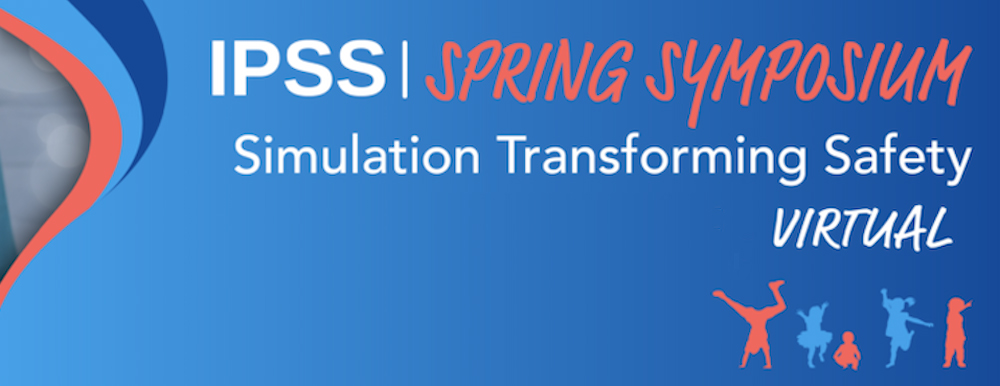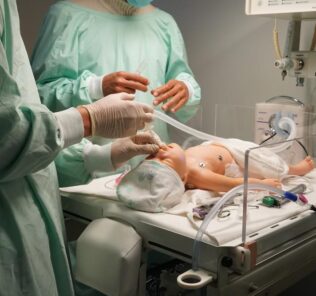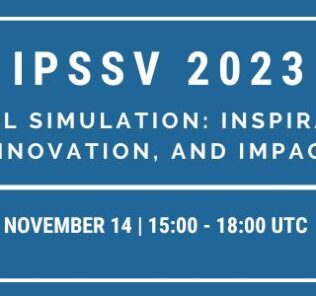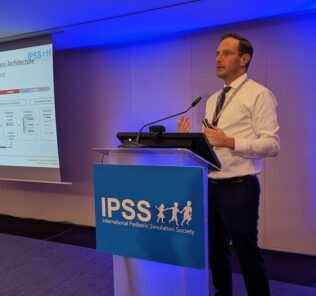IPSS Virtual Spring Symposium: Simulation Transforming Safety
The International Pediatric Simulation Society (IPSS) promotes and supports multi-disciplinary simulation-based education in caring for infants and children. Although focused on pediatrics, the 2021 IPSS Virtual Symposium focused on two general healthcare simulation topics which relate to all age groups. The symposium explored the use of healthcare simulation through the lens of Safety II to address healthcare resiliency and adaptability and the application of design thinking to simulation to test systems. This article shares other takeaways from the simulation symposium:
Simulation Practice: A New Model of Safety
The morning keynote address was given by Dr. Carl Horsley, Intensivist for Counties Manukau Health, Auckland, New Zealand, and Clinical Lead for Patient Safety, Health Quality and Safety Commission. Dr. Horsley reviewed problems with the current model of safety (Safety I) and then examined a new view of safety (Safety II) with an emphasis on the new model’s meaning for simulation.
Sponsored Content:
Safety I: Relatively little progress has been made over the last 20 years in preventing medical errors. The Safety I model revolves around a reactive response to an event when something in the system goes wrong or risks to patients are considered too high. Research into the cause of errors focuses on retrospective data reviews in an attempt to identify cause and effect. Following such an event, new policies and procedures are developed to address perceived problems. The system becomes more complex and clinicians are bogged down with more rules and regulations. People themselves are considered a safety hazard.
Safety II: Based on work by Hollnagel, Dr. Horsley suggests that more emphasis should be placed on determining what it is that people are doing that results in safe patient care most of the time. He notes “The system only succeeds because people/teams are able to adjust to meet the conditions of work.” The new model focuses on teams and people ensuring “that as many things as possible go right.” Action is proactive and people are considered a resource.
The Safety II model necessitates seeing people in their everyday work environment, seeing what they do that the majority of time keeps patients safe. All events should be evaluated including unwanted outcomes, everyday actions and outcomes and positive surprises. Dr. Horsley defines resilience as the “ability of the team/system to adjust performance to achieve its goals, even when the unexpected happens.” Resilience is not about the individual or just the front line but includes the systems as a whole.
Further, teams and individuals should know what to expect, look for, do and consider what has happened. These steps are interrelated and non linear. Differences between team members should be acknowledged and valued since different perspectives may enhance the adaptability of the team. Dr. Horsley noted that resilient healthcare is “the capacity to adapt to challenges and changes at different system levels, to maintain high quality care” (Wing et al. 2020).
Sponsored Content:
A common framework was presented at the symposium as a guide for teams to follow Safety II recommendations. The guide included steps to ensure that everyone knows what is going on, who is doing what, clear communication and whether patient goals are being met.
Simulation can play a critical role in this process by allowing the study of teams, equipment, artefacts, facilities, relationships and culture in situ. There may be a gap between work-as-done and work-as-imagined which simulation can be revealed. Dr. Horsley noted that interwoven simulation which includes modelling by senior staff and debriefing clinical events is beneficial. Positive feedback from staff at his own facility suggests that staff felt more engaged, had more insights about work, and that teams worked together for each other and to prevent patient harm.
Following Dr. Horsley’s very informative presentation, attendees broke into four workshops where the groups had the opportunity to complete Mural Survey Boards based on the following topics. At the end of the workshop sessions, a summary of each group was reported back to participants as a whole.
- Cultivating Resilient Capacities
- Bridging the Gap between Work-as-Done, Work-as-Imagined, and Work-as-Simulated
- Incorporating Interwoven Simulation
- Debriefing the System: Cognition in the Wild
Simulation Informed Design: A Focus on the User Experience
The second keynote of the symposium was presented by Dr. Andrew Petrosoniak, Emergency Physician & Trauma Team Leader, Assistant Professor St. Michael’s Hospital and University of Toronto. Dr. Petrosoniak started his presentation by quoting from Steve Jobs “Design is not just what it looks and feels like. Design is how it works.”
Apple products may have beautiful packaging and appearance but ultimately, it is the end user experience that is crucial. Likewise, the plexiglass aerosol box developed at the beginning of the COVID-19 pandemic to protect clinicians intubating patients was quickly abandoned because it damaged PPE, fell on patients, delayed intubation and allowed air to pass from patient to practitioner. Had the box been tested prior to launch to see how people would use the box, it likely would have been abandoned sooner.
Dr. Petrosoniak suggests that the use of Design Thinking would provide better understanding about humans and how they use things. Design Thinking is an interactive non-random process that takes time and follows a systematic framework or guideline so that structural changes can be made with each cycle. Instead of focusing on solutions, a five-step process should be followed — empathize, define, ideate, prototype and test.
Dr Petrosoniak gave the example of the development of a new trauma bay. Initially, architects designed a three-bed unit. But following multiple direct observations (simulations) and movement tracking with the three-bed setup in the allotted space, that the initial designs of the space including the number of beds and equipment were impractical became apparent.
In another example, clinicians could not understand why blood collection for critical ED events should take 15 minutes to arrive since the blood bank was only one floor below the ED. In this case, the people collecting blood (porters) had no perception of the critical nature of blood administration, did not hurry and actually used busy elevators full of people moving to and from a cafeteria.
Dr. Petrosoniak noted that brainstorming, though underutilized, can be very helpful. Participants in brainstorming should be encouraged to be creative and even “a little crazy.” The moderator should respond positively to suggestions.
They should not respond with a “no, but” but rather “yes and.” For example, prototype cars are often exotic and are very unlikely to ever become a reality; however, some of the design concepts in the fancy car may well be adopted in other more practical vehicles. The “define and ideate” stages of development should involve regularly scheduled planning meetings.
The empathize phase can involve simulations, interviews and/or direct clinical observations. Prototype development may involve table top and mock up simulations while final testing would involve in situ simulation. The process is not linear and the process can move backwards and forwards to repeat steps. As one change is made, a repeat of previous steps may be necessary.
Hospital leadership does not always think of the end user and may not be supportive of simulation. Dr. Petrosoniak quoted Ralf Speth, CEO of Jaguar, “if you think good design is expensive, you should look at the cost of bad design.” Electronic health records are an example of this. Many clinicians complain about EHRs which were developed without adequate input from the clinicians who will use them.
Leadership, which looks for return on investment, may fail to realize that money spent on simulation in early development may not only reduce the cost of design changes later on but ultimately result in quicker treatment times, less admits to ICUs and overall improved patient safety. In his own facility, Dr. Petrosoniak noted that initially, simulation was not supported; however, now the simulation department cannot keep up with demands for assistance in development projects.
The symposium then offered opportunities for attendees to participate in some live examples of design thinking. First was a live empathy interview entitled: “Understand the problem from the perspective of the end user.” Dr. Peter Weinstock interviewed an extracorporeal cardiopulmonary resuscitation (ECPR) specialist about a middle of the night call out for a pediatric ECMO hookup. Dr. Weinstock traced the specialists’ emotions about the experience in an attempt to understand the end user perspective.
The interview followed four guidelines including leveraging emotions to identify key challenges, utilizing open ended questions, seeking to understand and remaining non judgemental. Next the IPSS staff announced a huge in person party at the IPSS meeting scheduled for 2022. Finally, there came two breakout sessions where each group was presented with a healthcare-related design problem. The groups were shown a photo of a very crowded OR with one nurse having to step over a cord as she moved around the area.
The group was challenged to come up with solutions using “yes and” statements. Data was collected and the most popular solutions reported back to the whole group. The second component of this workshop activity was to brainstorm ways to create a prototype piece of equipment from readily available and inexpensive materials.
The IPSS six-hour symposium was packed full of helpful information and creative workshops. The presenters were knowledgeable and supportive and, if you get a chance to view these sessions, I would highly recommend that you seize the opportunity.
Learn More About IPSS Events
Dr. Kim Baily, MSN, PhD, RN, CNE has had a passion for healthcare simulation since she pulled her first sim man out of the closet and into the light in 2002. She has been a full-time educator and director of nursing and was responsible for building and implementing two nursing simulation programs at El Camino College and Pasadena City College in Southern California. Dr. Baily is a member of both INACSL and SSH. She serves as a consultant for emerging clinical simulation programs and has previously chaired Southern California Simulation Collaborative, which supports healthcare professionals working in healthcare simulation in both hospitals and academic institutions throughout Southern California. Dr. Baily has taught a variety of nursing and medical simulation-related courses in a variety of forums, such as on-site simulation in healthcare debriefing workshops and online courses. Since retiring from full time teaching, she has written over 100 healthcare simulation educational articles for HealthySimulation.com while traveling around the country via her RV out of California.
Sponsored Content:


















